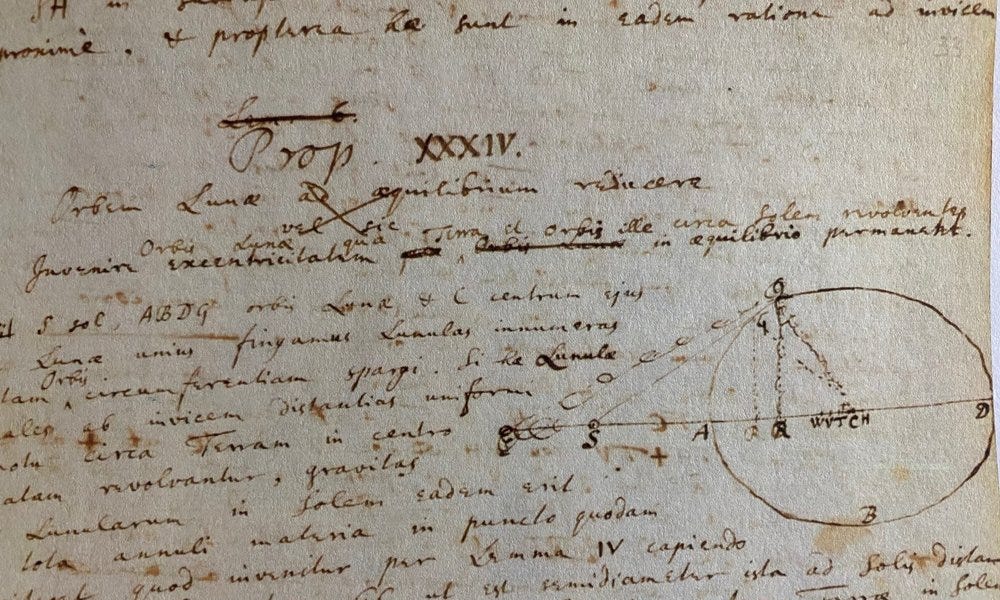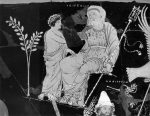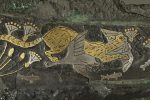A page from a handwritten draft of Newton’s Principia.
Twice a year, the sun appears to pause in its path across the sky—day and night balance, and a subtle shift in the seasons begins. For the ancients, these moments held agricultural, ritual, and philosophical significance. But beyond observation came the question: why do these celestial patterns occur?
Whilst the ancients were generally aware of equinoxes and solstices, Eudoxus of Cnidus (circa 390-337 BCE) was among the first to attempt to explain why they occur.
Eudoxus of Cnidus and the geometry of the heavens
Eudoxus of Cnidus’ model of concentric celestial spheres revolving around the Earth at different speeds offered a way to understand the pattern of longer days in summer and shorter days in winter, necessitating, of course, the equinoxes in between.
Eudoxus’ theories were summarised (and criticised) by his contemporary (and fellow student at the Academy) Aristotle:
Εὔδοξος μὲν οὖν ἡλίου καὶ σελήνης ἑκατέρου τὴν φορὰν ἐν τρισὶν ἐτίθετ’ εἶναι σφαίραις, ὧν τὴν μὲν πρώτην τὴν τῶν ἀπλανῶν ἄστρων εἶναι, τὴν δὲ δευτέραν κατὰ τὸν διὰ μέσων τῶν ζῳδίων, τὴν δὲ τρίτην κατὰ τὸν λελοξωμένον ἐν τῷ πλάτει τῶν ζῳδίων· ἐν μείζονι δὲ πλάτει λελοξῶσθαι καθ’ ὃν ἡ σελήνη φέρεται ἢ καθ’ ὃν ὁ ἥλιος.
Aristotle, Metaphysics 12.1073b17–22
Eudoxus held that the motion of the sun and moon
involves in either case three spheres, of which the
outermost is that of the fixed stars, the second revolves
in the circle which bisects the zodiac, and the third
revolves in a circle which is inclined across the breadth
of the zodiac; but the circle in which the moon moves is
inclined at a greater angle than that in which the sun
moves.
(trans. Hugh Tredennick, Loeb 1933)
Hipparchus and the mystery of the moving stars
Eudoxus’ ideas were further developed by Hipparchus (circa 190-120 BCE).
Whilst Eudoxus’ concentric spheres accounted for the general motion of the stars, planets, and sun, Hipparchus recognized an additional subtlety: the positions of the equinoxes relative to the zodiac were slowly shifting over centuries of star-keeping records. Eudoxus’ model could not account for this.
For example, when Hesiod advised his audience to begin their harvest when the Pleiades were rising, he was describing a constellation that in the 700s BCE appeared during late May to early June. In our era, this constellation rises in late June to early July.
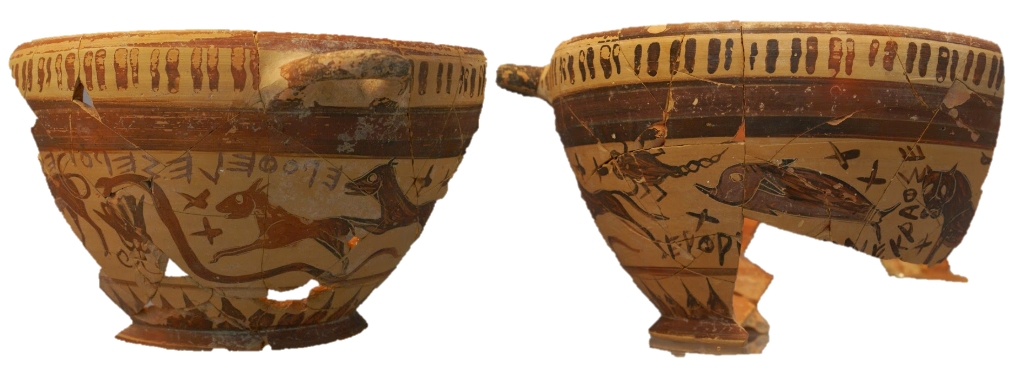
Images of a skyphos (circa 625 BCE) found north of Thebes which may depict constellations. (John T. Barnes. “Asteras Eipein: An Archaic View of the Constellations from Halai.” Hesperia: The Journal of the American School of Classical Studies at Athens 83, no. 2 (2014): 257–76. https://doi.org/10.2972/hesperia.83.2.0257.)
Likewise, in ancient Greece, the autumn equinox occurred when the sun was in the constellation of Libra. Today, it occurs when the sun is in Virgo.
Claudius Ptolemy and the legacy of precision
Hipparchus’ theories are preserved for us by Claudius Ptolemy (2nd century CE), the great Alexandrian mathematician and astronomer whose monumental work, the Almagest, became the foundation for much of Western and Islamic astronomy for the next thousand years. The text, originally called the Μαθηματική Σύνταξις (Mathematical Treatise), later became known as ἡ μεγίστη (The Greatest Treatise); the title Almagest comes from al majisti, a transliteration of the Arabic اَلْمَجِسْطِيّ.
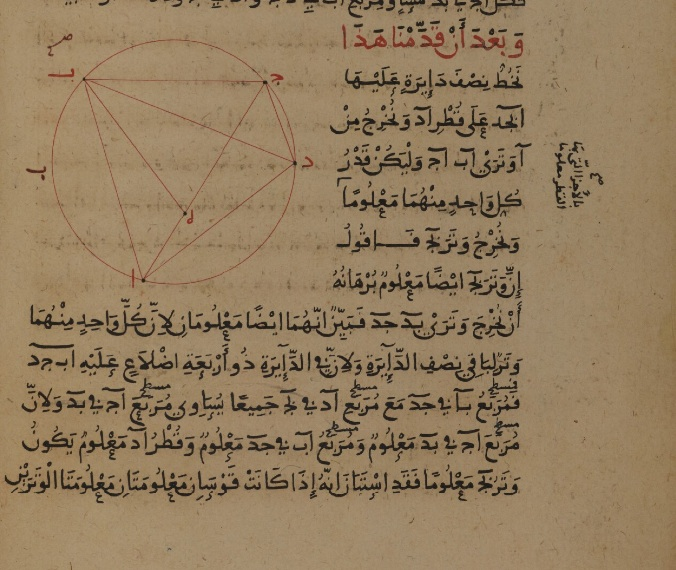
Astronomical diagram from the Almagest of Ptolemy, 1287 CE (British Library Add MS 7474, f.11v).
Ptolemy writes:
ὅ τε γὰρ Ἵππαρχος ἐν τῷ Περὶ τῆς μεταπτώσεως τῶν τροπικῶν καὶ ἰσημερινῶν σημείων … ἐπιλογίζεται τὸν Στάχυv ἀπέχοντα τοῦ μετοπωρινοῦ σημείου εἰς τὰ προηγούμενα ἐν μὲν τοῖς καθ᾿ ἑαυτὸν χρόνοις μοίρας Σ, ἐν δὲ τοῖς κατὰ Τιμόχαριν Η ἔγγιστα μοίρας· … σχεδὸν δὲ καὶ ἐπὶ τῶν ἄλλων ἀλπανῶν, ὧν πεποίηται τὴν σύγκρισιν, τὴν τοσαύτην εἰς τὰ ἑπόμενα παραχώρησιν ἀποδείκνυσι γεγενημένην. ἡμεῖς τε τὰ καθ᾿ ἑαυτοὺς φαινόμενα τῶν ἀπλανῶν διαστήματα πρὸς τὰ τροπικὰ καὶ ἰσημερινὰ σημεῖα παραβάλλοντες τοῖς ὑπὸ τοῦ Ἱππάρχου τετηρημένοις τε καὶ ἀναγεγραμμένοις οὐδὲν ἧττον εὑρίσκομεν τὴν εἰς τὰ ἑπόμενα τοῦ διὰ μέσων παραχώρησιν αὐτῶν ἀναλόγως τῇ προκειμένῃ μεταβάσει γεγενημένην.
Ptolemy, Syntaxis Mathematica 1,2 β´
(ed. Heiberg, Teubner 1898–1903, vol.2, p.13)
For Hipparchus too, in his work On the Displacement of the Solstitial and Equinoctial Points, … computes that the distance by which Spica (the brightest star in the constellation Virgo) is in advance of the autumnal [equinoctial] point is about 6° in his own time, but was about 8° in Timocharis’ time. … Furthermore he shows that in the case of almost all the other fixed stars for which he carried out the comparison, the rearward motion was of the same amount. And we also, comparing the distances of fixed stars from the solstitial and equinoctial points as they appear in our time with those observed and recorded by Hipparchus, find that their motion towards the rear … is, proportionally, similar to the above amount.
(trans. G.J. Toomer, Ptolemy’s Almagest, Duckworth 1984, p.328)
Newton and the long arc of astronomical understanding
One might wonder why the motion of the ‘fixed stars’ or the zodiac is to be correlated with the equinoxes and solstices. The answer is that although the ‘fixed stars’ inhabit one celestial sphere, and the sun inhabits another, these celestial spheres were assumed to rotate around the Earth (at the centre of the universe) in perfect synchronisation. Hipparchus discovered an anomaly in this worldview, termed ‘the precession of the equinoxes’, that wouldn’t fully be explained until Newton’s Law of Gravitation (published in his Principia,1687) revealed that the gravitational pull of the sun and the moon on the Earth cause it to wobble on its axis as it rotates, like a spinning top.
Vis autem lunae ad mare movendum erat ad vim solis ut 4,4815 ad 1 circiter. Et vis lunae ad aequinoctia movenda est ad vim solis in eadem proportione. Indeque prodit annua aequinoctiorum praecessio a vi lunae oriunda 40″ 52‴ 52iv, ac tota praecessio annua a vi utraque oriunda 50″ 00‴ 12iv. Et hic motus cum phaenomenis congruit. Nam praecessio aequinoctiorum ex observationibus astronimicis est annuatim minutorum secundorum plus minus quinquaginta. … Descripsimus iam systema solis, terrae, lunae, et planetarum: superest ut de cometis nonnulla adiiciantur.
Isaac Newton, Philosophiae Naturalis Principia Mathematica, Book III, Proposition 39, Problem 20 (Sir Isaac Newton’s Principia, pub. Maclehose: Glasgow, 1871, p.477)
The force of the moon to move the sea was to the force of the sun nearly as 4,4815 to 1; and the force of the moon to move the equinoxes is to that of the sun in the same proportion. Whence the annual precession of the equinoxes proceeding from the force of the moon comes our 40″ 52‴ 52iv and the total annual precession arising from the united forces of both will be 50″ 00‴ 12iv, the quantity of which motion agrees with the phaenomena; for the precession of the equinoxes, by astronomical observations, is about 50″ yearly. … And now we have described the system of the sun, the earth, moon, and planets, it remains that we add something about the comets.
(Trans. Andrew Motte, New York, 1846, p.459)
This development of the study of astronomy, and with it the scientific understanding of humanity’s place in the universe, is a classic example of the sort of collaboration across time and place that studying history reveals to us. Whilst Ptolemy credits the Babylonians’ centuries of precise record keeping for his ability to compute astronomical events (Almagest, III.7), Newton’s own debt was to both Ptolemy and Hipparchus, without whose observations he might not have been able to develop and verify his laws of motion and gravitation.
On this autumn equinox day, or, as Eudoxus might have said, as the celestial spheres of the Sun and Libra come into alignment, we reflect on how our modern world was painstakingly constructed by writers and thinkers across hundreds of generations. We invite you to join our Latin and Ancient Greek classes and learn how to read them in their own words.
